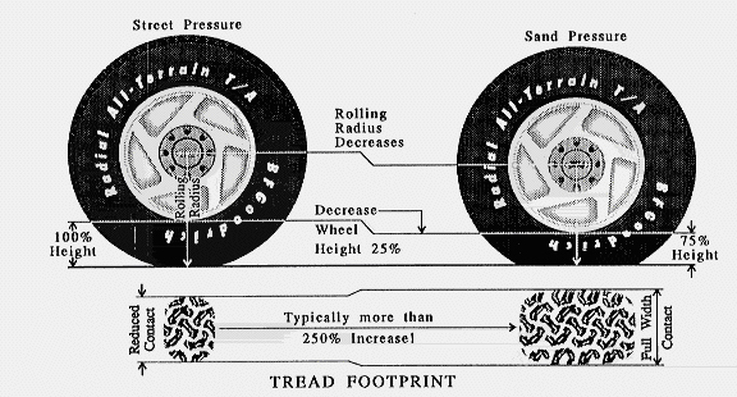Did you use the low range and diff locker on the Jeep? Do you have HSE or V8SC? If i recall correctly, the HSE does not have a 4 low option but the V8SC does.
Airing down 275-45-21s won't help you much. The airing down of the tire is to increase the length & slightly, the width of the tire's foot print. With a 45 aspect ratio tire (sidewall height equals 45% of the tire width) you won't gain much length and almost no width because the side walls are quite stiff due to the rim being lower to the ground. There is something to gain, but it's not much. Now if you have a 75 aspect ratio tire, you could more than double the length of the tire foot print by dropping to 10-15 psi from 35ps. Here is a illustration.
![Image]()
If you want to air down with those low profiles, to find a sand pressure to start with, air your tire to normal street driving pressure. Then set a brick approximately 1/2" away from the side wall where the tire contacts the ground. Let the air out until the sidewall touches the brick. Then test the tire pressure. That pressure will be about what you'll use should you want to air them down for sand driving. I'm not sure how much foot print you'll gain, but my guess is that it won't be more than 5-10%. But i suppose it all helps. Always air up immediately upon returning to the pavement.
Almost all people get stuck when turning, starting or stopping on the sand. The other common time they get stuck is when their vehicle comes to a stop but they continue to try and accelerate. When your vehicle stops in sand, stop trying to accelerate. You can almost always back out if you haven't dug yourself into a hole by trying to power out of the stoppage.
A lot of people say just keep your speed up and you'll be fine. Even the quote below talks bout "planing" on the sand. But too much speed can start to push your front tires through the sand rather than allowing them to roll over the sand. When the tires are pushed, sand builds up in front of them making it more difficult for them to roll over and may eventually cause you to get stuck. There is a happy medium when it comes to speed, but many factors determine what that happy medium is. Type of sand, hills or flat, 4 or 2 wheel drive, tire pressure, tire tread pattern, etc... When you experience this, it will feel like you're slowing down even though you're trying to accelerate more. Sometimes, just easing off of the throttle a little but will give the front tires time to roll over rather than push through. You'll develop a feel for it with more experience.
I quoted some tips from a website that describes more of the places you'll be traveling.
When traveling on sand, you should endeavor to follow in the tire tracks of the vehicle in front as they have already compressed the sand to form a firmer surface than un-traversed ground. Never drive on vegetation as this will destroy it and lead to erosion and environmental damage.
You should avoid rapid changes in speed when accelerating or braking. Braking on sand will cause a mound to build up in front of all wheels and possibly prevent your vehicle from taking off. Rapid acceleration simply digs the wheels in and can actually lead to slower take-off speeds.
Take-off should be performed as smoothly as possible with gear changes done at fairly high revs. Sand driving requires plenty of engine power to get your vehicle "planing" on the sand. It is advisable to use low range as this multiplies the amount of engine torque available and will provide that extra gear if you encounter a particularly soft patch of sand. Check that your tires are pointing straight ahead when taking off to reduce the takeoff effort required.
When stopping on sand, depress the clutch and allow the vehicle to coast to a stop. This will minimize any sand build-up in front of the wheels. If the terrain permits, coast to a stop, rather than braking, with the vehicle pointing downhill as this will aid take-off. Avoid the soft sand at the base of most dunes and gullies when stopping.
When turning, make the turn as wide as possible to reduce the chance of bogging. Your front wheels act more like a rudder in sand and turning too sharp has a similar effect to applying the brakes.
Steep sand dunes can be traversed only straight up or down. If you drive even on a slight angle, the weight transfer is to the downhill side wheels. If the vehicle starts to slip, the downhill wheels tend to dig in and make the angle of the dune even worse, leading to a potential rollover.
If you are traveling straight down a steep dune and the back end starts to slip sideways, it is best to accelerate slightly to try and straighten the vehicle. Never use the brake, as this will cause weight transfer to the front wheels and can increase the back end movement.
If traveling up a dune and you do not get to the top, reverse down the dune in gear, NEVER coast down the dune and NEVER attempt a U turn.
When you return home after a beach trip, it is important to hose down your vehicle to remove all traces of sand and salt. Pay special attention to areas like the mudguards where sand is sprayed around and tends to get trapped. Thoroughly hose underneath your vehicle as well, as there are many nooks and crannies where sand con also get trapped.







